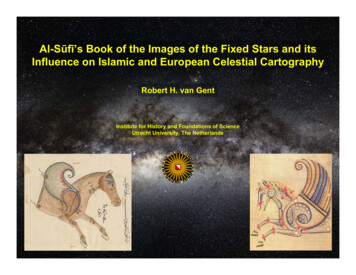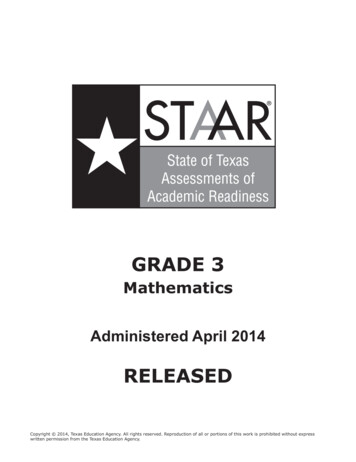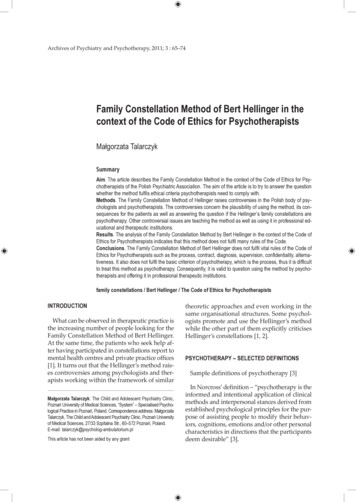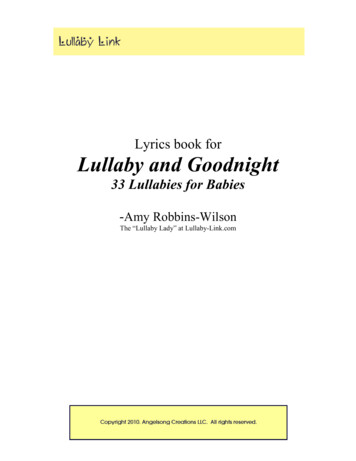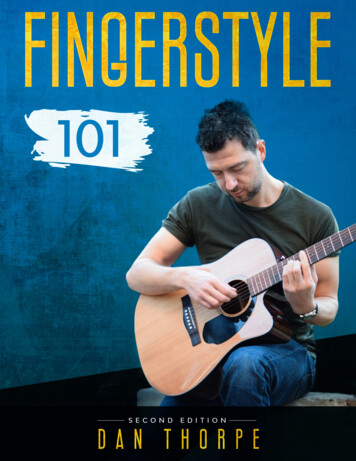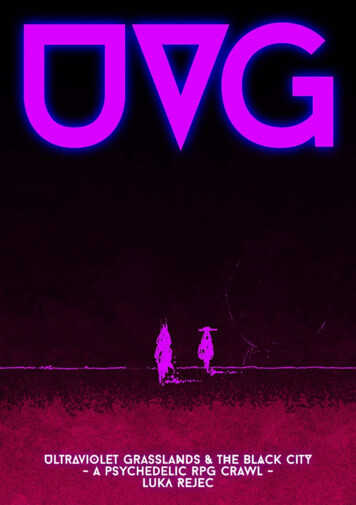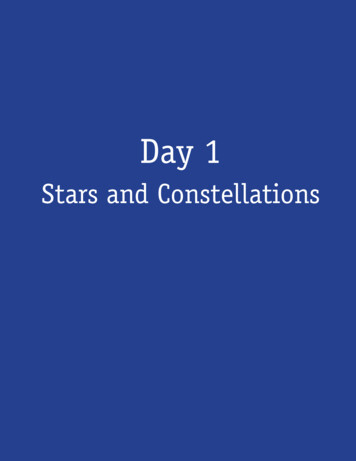
Transcription
Day 1Stars and Constellations
Day 1Stars and constellations1IntroductionThis day focuses on one of the most awesome things we can see in the night sky: stars and starpatterns that we call constellations. Stars are big exploding balls of gas — mostly hydrogenand helium — held together by their own gravity. Astronomers think that there are 200billion stars in the Milky Way, the galaxy where our own solar system lives.Questions to guide explorations and experiments What is a star? Why do they shine and seem to twinkle? Where do stars come from? What is a constellation? Why did people name patterns of stars and create stories about them?Books and activities Books: fiction, nonfiction and poetry all about stars, constellations, and comets Activities: explore why stars twinkle, look at constellations, and create a "starnursery" nebula6
Day 2: Stars and constellationsChildren's Books1Fiction A Big Mooncake for Little Star by Grace Lin (Ages 4-7) Blackout by John Rocco (Ages 6-9) Bright Sky, Starry City by Uma Krishnaswami (Ages 6-9) Coyote Places the Stars by Harriet Peck-Taylor (Ages 4-8) Her Seven Brothers by Paul Goble (Ages 6-9) How the Stars Fell into the Sky by Jerrie Oughton 6-9) The Story of the Milky Way by Joseph Bruchac (Ages 6-9)Poetry Comets, Stars, the Moon, and Mars: Space Poems and Paintings by Douglas Florian (Ages 6-9) Once Upon a Star: A Poetic Journey Through Space by James Carter (Ages 6-9) Out of This World: Poems and Facts About Space by Amy Sklansky (Ages 6-9) Stuff of Stars by Marion Bauer (Ages 6-9)Nonfiction The Big Dipper by Franklyn Branley (Ages 6-9) A Child's Introduction to the Night Sky by Steve Parker (Ages 9-12) Find the Constellations by HA Rey (Ages 9-12) Glow-in-the-Dark Constellations by CE Thompson (Ages 6-9) The Great Race: The Story of the Chinese Zodiac by Dawn Casey (Ages 4-7) A Hundred Billion Trillion Stars by Seth Fishman (Ages 6-9) The Kids' Book of the Night Sky by Ann Love and Jane Drake (Ages 9-12) Look Up! Henrietta Leavitt, Pioneering Woman Astronomer by Robert Burleigh (Ages 6-9) Once Upon a Starry Night: A Book of Constellations by Jacqueline Mitton (Ages 6-9) The Sky Is Full of Stars by Franklyn Branley (Ages 6-9) The Stars: A New Way to See Them by HA Rey (Ages 9-12) Wishing on a Star: Constellation Stories and Stargazing Activities for Kids by Fran Lee (Ages 6-9) Zoo in the Sky: A Book of Animal Constellations by Jacqueline Mitton (Ages 6-9)7
Day 2: Stars and constellationsSpace WordsAstronomer / Astronomy1Light yearA scientist who studies space and the Universebeyond Earth. Astronomy is the branch of sciencethat studies space.The distance that light travels in one year, about 6billion miles.Little DipperAtmosphereThe layer of gases surrounding Earth and otherplanets, held in place by gravity.The constellation Ursa Minor (Little Bear). The starsthat make up this constellation also form a patternthat looks like a dipper.Big DipperMilky WayPart of the constellation Ursa Major (Big Bear), madeup of this constellation's seven brightest stars. Thesestars form a shape that looks like a ladle, or dipper.The galaxy that contains the Earth, the Sun, and thesolar system. It can be seen in the night sky as a long,cloudy group of stars.ConstellationNebulaA group of stars in the night sky forming patternsthat look like animals, objects, or characters. Thereare 88 official constellations. At different times ofthe year and in different hemispheres, differentconstellations can be seen in the sky.A cloud of dust and gas found in interstellar space.They are sometimes called "star nurseries" becausestars are created there.OrionA large winter constellation in the northern sky. InGreek mythology, a hunter.GalaxyA collection of billions of stars and other matterheld together by gravity. Our planet Earth and thesun belong to the Milky Way galaxy. A telescopehelps us see other galaxies from Earth.Polaris (North Star)A bright star in the constellation Ursa Minor (LittleDipper). It seems to remain in a constant position inthe sky; for this reason, Polaris is used for navigation.GravityA force that pulls matter together; a force that pullspeople and objects toward the ground.RefractHeliumA gas that is lighter than air. Balloons filled withhelium will float high in the sky.To bend as you move from one medium to another.Example: The movement of air and dust in the atmosphere bends, or refracts, a star’s light in differentdirections.Hubble TelescopeScintillationA space telescope launched into low Earth orbit in1990 and is still out there. The Hubble has takenthousands of images that have helped scientistsand the public to understand our Universe better.A spark, flash, or twinkle of light.StarA giant ball of hot gas that emits light and energycreated through nuclear fusion at its core.HydrogenTelescopeA very light gas and one of the most abundantgases in the Universe.An instrument that uses lenses and mirrors to makefar away objects look larger and closer to us.InterstellarThe space located between stars.7
Day 2: Stars and constellationsActivity 1: Twinkle, Twinkle1IntroductionStars are so far away from Earth that, even through large telescopes, they appear only as tinypoints of bright light. Stars seem to twinkle because we see them through the layers of theatmosphere — the gases that surround our planet.The movement of air and dust in the atmosphere bends, or refracts, a star’s light in differentdirections. Because the light is scattered by the time it reaches our eyes on Earth, stars appearto twinkle. You might think of it as the light traveling a zig-zag path to our eyes, instead of thestraight path the light would travel if Earth didn’t have an atmosphere.Supplies 12-inch x 12-inch square of aluminum foil 2-quart glass bowl Water Flashlight Pencil (optional)This activity works best in a darkened roomGet kids thinkingIn this activity, kids will be exploring why stars appear to twinkle.Ask kids: Have you ever looked at stars in the night sky? What have you observed?Have you ever looked up high in the night sky at the stars and then moved your head downcloser to the horizon. Do the stars seem to change?Stars closer to the horizon will appear to twinkle more than stars higher up in the sky becausethere is a lot more atmosphere between you and a star near the horizon.8
Day 2: Stars and constellationsActivity 1: Twinkle, Twinkle1Let's get started!Demonstrate this activity in front of the kids, and then let them try it themselves in smallgroups. Crumple your square of foil, then open it up, and place it on a table or on the floor.Fill your clear bowl with tap water and place it on top of the crumpled foil.Darken the room by turning off the lights. Hold the flashlight about 12 inches above the bowl.Look at the foil through the undisturbed water. Ask the kids: What does the reflected lightlook like?Now using your finger or a pencil, tap the surface of the water gently. Look at the foil throughthe moving water. Ask the kids: How does the reflected light look like now?What happened? The light rays reflecting from the foil when there was a movement in waterappears to blur or twinkle.Why? The movement of the water causes the depth of the water to vary. The light rays twinklebecause they bend or refract in different direction when it passed through the differentdepths of water.This is similar to the light rays from the stars. They appear to be twinkling when you areobserving from Earth because they refract differently as the light rays move through thedifferent thickness of air in the atmosphere. The scientific word for this twinkling phenomenonis scintillation.More activitiesDo Stars Really Twinkle (video)https://www.youtube.com/watch?v -GfIT6jK449
Day 2: Stars and constellations1Activity 2: Explore ConstellationsThree WaysIntroductionA constellation is group of stars that make up an imaginary shape in the night sky.In ancient times, people saw patterns of stars in the night sky that seemed to makerecognizable shapes. Some of them are named after mythical heroes like Hercules and Orionthe Hunter. Other star patterns are named after animals, like Ursa Major — the big bear.The star patterns became a way to preserve stories, like the legend of Perseus rescuing theprincess Andromeda from a sea monster named Cetus.As astronomers began mapping the night sky, these star patternswere included in the maps and called “constellations.” Thereare 88 official constellations, according to the InternationalAstronomical Union. At different times of the year, differentconstellations can be seen in the sky.Sailors have used constellations to help with navigation forthousands of years. It's pretty easy to spot Polaris (North Star)once you've found Ursa Minor (Little Dipper).Get kids thinking Have you ever looked for the Little Dipper and the North Star in the night sky? Can you guess why we see different constellations in the summer night sky than we see inthe fall, winter, or spring? In the summer, we can see Hercules the Hero but we can't seeOrion the Hunter (we see Orion in the winter sky). Do you know any stories about constellations, like the stories of Hercules, Orion the Hunter,or Pegasus the winged horse?This would be a great time to read a story about constellations, such as this Native Americantale about the creation of the Big Dipper such as Her Seven Brothers by Paul Goble. Or youcould read one of the stories from these books by Jaqueline Mitton: Zoo in the Sky or Once Upona Starry Night.10
Day 2: Stars and constellations1Activity 2: Explore ConstellationsThree WaysOption 1: Sidewalk Chalk ConstellationsSupplies Summer sky constellation template and constellation card templates (provided) Buckets of sidewalk chalk Plastic buckets with rocks, pebbles, bottle caps (these are the "stars" in your constellation)Let's get started!In this activity, kids will build a favorite constellation outside using rocks, pebbles, bottle caps,and chalk.Print out a copy of the summer sky constellation chart for each child. Also print out enough ofthe individual constellation pages so that the kids will have some options when they choosetheir constellation for this activity. The templates can be found after page 23.Get everyone together in a circle, pass around the summer sky constellation charts, and talkabout the different constellations on the chart. Ask the kids: Can you identify any of theanimals or characters?Tell the kids that you've set out copies of different constellations on the table, and invite thekids to select one that they would like to "build" outside.Time to head outside! Bring the buckets of rocks, pebbles and bottle caps outside wherethere's lots of sidewalk space. Show the kids how to draw their constellation on the sidewalk,starting with the pebbles, rocks, and bottle caps (these are the "stars") and then use the chalkto connect the stars and complete their constellation. Thing big! And don't forget to have thekids write the names of their constellations in chalk next to their creation.11
Day 2: Stars and constellations1Activity 2: Explore ConstellationsThree WaysOption 1: Sidewalk Chalk ConstellationsAs a group, take a walking tour of your "night sky" and encourage each child to identify theirconstellation, and share a story about their animal or character if they know one.To extend this activity, you can encourage the kids to create their own constellations —the "sky's the limit" when it comes to using their imaginations!Photo Creekside Learning12
Day 2: Stars and constellations1Activity 2: Explore ConstellationsThree WaysOption 2: Constellation Light ShowSupplies Constellation card templates (provided) Black construction paper (8-1/2 x 11),one sheet for each child Sharpened pencils or toothpicks Tape Flashlight Pieces of cardboardThis activity needs a darkened roomLet's get started!In this activity, kids will prepare a constellation for a group light show in the dark.Print out enough copies of the individual constellation pages so that the kids will have someoptions when they choose their constellation. The templates can be found after page 23.Ask the kids to choose a favorite constellation. Show them how to tape their constellationtemplate to a sheet of black paper, and then put the taped constellation on top of a piece ofcardboard to protect the surface you are working on when you poke holes in the paper.Tell the kids that each of the dots on the constellation sheet represents a star. Using a smallpointed object (a pen or toothpick works well), show them how to poke holes in the dots foreach star.Then gather all the kids together in the room for the starry night show! Turn off all the lights inthe room, hold your paper up to the wall and shine the flashlight behind it. Everyone will seethe stars of your constellation light up on the wall. Give each child a turn to show theirconstellation to the group.13
Day 2: Stars and constellations1Activity 2: Explore ConstellationsThree WaysOption 3: If I Was a Constellation (Life-SizedConstellations)IntroductionShow kids the constellation Orion and discuss with them how the stars mark his shoulders andhis belt, sword, and shield. Tell them the story of Orion and as a group, write an acrostic poem.Supplies Orion constellation illustration (provided) Roll of black paper (at least 36” wide) — you can use white if black is not available. 8-1/2 x 11 white paper Stars cut out of yellow construction paper (about 8-10 2-inch stars per child) Pencils, pens, markers White chalk — or colored chalk if using white paper on the wall TapeLet's get started!In this activity, kids will invent their own life-sized constellations. After telling the Orion story,ask the kids to think about how they might create their own character or animal constellationby posing with their bodies.Tape kid-sized sheets of paper to the wall and have each child stand in the constellation poseof their own invention in front of their paper. Mark the main points of the body with pencilor marker — just make a small "X".14
Day 2: Stars and constellations1Activity 2: Explore ConstellationsThree WaysOption 3: If I Was a ConstellationNext, have the kids tape the paper stars to the main points on the body, on top of the "X".They can connect the stars with the marker if they'd like to. Tell kids: That's you as a life-sizedconstellation!Ask the kids to give their constellation a name, write it on a sheet of paper in acrostic style(vertically, and then write a descriptive acrostic poem for their invented constellation.More constellation activitiesConstellation Centerpiece (PBS onstellation Viewers (Literary lations-astronomy-for-kids.html15
Day 2: Stars and constellationsActivity 3: Nebulas Where Stars Are Born1IntroductionA nebula is an interstellar cloud of dust and gas. Some nebulas are called “star nurseries”because that’s where stars are formed, or "born." Our own Sun was born 4.6 billion years ago!Supplies (for each child) Clear glass jar with a lid Plastic spoon Water Tempera paint (at least 2 colors, blues, purples, and pinks work well) Glitter Cotton balls (about 18 per child, depending on the size of the jar)Get kids thinkingIn this activity, kids will create a model of a nebula. A nebula looks like a big cloud of dustand gas located in interstellar space. They are very far away — the closest one to Earth iscalled the Helix Nebula and it is 700 light years away. That means even if you could travel atthe speed of light, it would take you 700 years to get there!Ask kids: If nebulas are so far away, how do we know what they look like? Astronomers usevery powerful space telescopes, such as the Hubble telescope, to take pictures of nebulas.Share photographs of the Helix Nebula and the Orion Nebula (see pages 17-18). If you haveaccess to the Internet, watch this video from NASA, Flight Through the Orion 1-180967825/16
Day 2: Stars and constellationsActivity 3: Nebulas Where Stars Are BornHelix Nebula171
Day 2: Stars and constellationsActivity 3: Nebulas Where Stars Are Born1Orion NebulaOn a clear night, if you look at the constellation Orion, you might get a glimpse of a starnursery. Below Orion's belt (near the tip of his sword) about 1,350 light years from Earth, thenebula looks like a mudge in the sky. But that hazy smudge is Orion Nebula, which createssome of the Milky Way’s newest stars.18
Day 2: Stars and constellationsActivity 3: Nebulas Where Stars Are Born1Let's get started!Have kids fill one-third of their glass jars with water. Tell kids to add a few drops of temperapaint to the jar and stir.Then have kids add 3-6 cotton balls (depending on the size of the jar) to the water mixture inthe jar, pressing down with the spoon. Next, ask kids to sprinkle in about a teaspoon of glitter.Tell the kids to repeat steps 1-4 two more times, or until their jar is full. Screw on the lid andyour nebula jar is ready to display.The nebula jar is a colorful (and even calming) object for a child’s room, plus they can proudlysay to visitors, “look, I made a nebula” and then explain what that word means!Photo PBS Parents19
Day 2: Stars and constellationsWriting About Stars1Writing helps kids process and solidify new knowledge and gives them an opportunity to usenew vocabulary and concepts. Offer one or more of these prompts or questions to get yourSpace Rangers writing.Write a constellation mythTalk about what a myth is — a made-up story that explains the existence of something innature, such as where thunder comes from or how the Milky Way formed. Myths often featuresupernatural and heroic characters who have the power to make amazing things things happen.Next, read a constellation myth to the group, and tell the kids that they'll be writing their ownconstellation myths.Give the kids a copy of the Summer Star Chart (see the next page) and paper, pens, pencils,and/or markers for writing and drawing.Look together at the stars on your star chart. What kinds of patterns do the kids see? Ask eachchild to find a cluster of stars and design a new constellation with its own modern-day myth.The constellation myth should explain how and why this particular constellation is in the sky.Share your stories in a group circle.Variation: Look at the Summer Star chart. Find two constellations that are neighbors and writea new story about the two characters together.20
Name:COLORANSWER KEYClass:Date:Copyright 2017 Anthony Iorlano & Linda Iorlano. All Rights Reserved.No part of this document may be reproduced without written consent from the author.
Day 2: Stars and constellationsWriting About Stars1Blackout poetryBlackout poetry is like a treasure hunt since you find hidden meanings and secret messagesin unlikely places. It also creates a beautiful “night sky” — with words as the twinkling stars ofyour poem.Create an example for the kids as you explain the activity.Supplies (for each child) Old newspapers or magazines Thin and thick black markers Highlighters (optional)How to1. Select a newspaper or magazine page.2. Look at all of the words on the page.3. Go back over the page, and with a thin blackmarker draw a box around the words that youwant in your poem.4. Color in (black out) the rest of the words onthe page with the thick black marker, leavingjust the words you selected.5. Highlight all or some of the words, if you like,to create a more colorful effect.21
Day 2: Stars and constellationsKid-friendly Websites and Apps1WebsitesConstellations (NASA Space tions/What Is a Nebula? (NASA Space Place)https://spaceplace.nasa.gov/nebula/en/This Week's Sky at a Glance (Sky and g/sky-at-a-glance/How to Find the Summer Constellations ing (Ranger Rick, National Wildlife Federation)https://rangerrick.org/crafts activities/try-stargazing/Flight Through the Orion Nebula video-1-180967825/How Many Stars Are There? (It's Okay to Be Smart, PBS Digital -how-many-stars-are-there/Super Stars: Constellations (Crash Course a-constellation-crash-course-kidsDK Find Out: Constellations (DK tellations/22
Day 2: Stars and constellationsKid-friendly Websites and AppsStargazing appsEach of these uses GPS to instantly map the sky from where you are standing.Star Chart (Android) chartSky Map ews/sky-mapStar Walk Astronomy Guide (Apple) the-insects-water-grass-editionRedshift Astronomy (Apple) ift-astronomy231
Big Dipper
Ursa Major, The Big Bear
Little Dipper (Ursa Minor, The Little Bear)
Orion, The Hunter
Cassiopeia, The Queen
Hercules, The Hero
Pegasus, The Winged Horse
Cygnus, The Swan
Lyra, The Lyre
Draco, The Dragon
Perseus, The Hero
Andromeda, The Princess
Aquarius, The Water Carrier
Aries, The Ram
Cancer, The Crab
Capricorn, The Goat with the Tail of a Fish
Gemini, The Twins
Leo, The Lion
Libra, The Scales
Pisces, The Fish
Sagitarius, The Archer
Scorpio, The Scorpion
Taurus, The Bull
Virgo, Goddess of Justice
Orion, The Hunter
How to find Polaris, the North StarPolaris appears to hold still in our sky, always pointing the way due northIf you can find the Big Dipper, you can find Polaris!The two outer stars in the bowl of the Big Dipper always pointto Polaris, the end of the handle of the Little Dipper.
Day 2: Stars and constellations 1 Children's Books Fiction A Big Mooncake for Little Star by Grace Lin (Ages 4-7) Blackout by John Rocco (Ages 6-9) Bright Sky, Starry City by Uma Krishnaswami (Ages 6-9) Coyote Places the Stars by Harriet Peck-Taylor (Ages 4-8) Her Seven Brothers by Paul Goble (Ages 6-9
